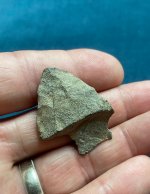Navigation
Install the app
How to install the app on iOS
Follow along with the video below to see how to install our site as a web app on your home screen.
Note: This feature may not be available in some browsers.
More options
You are using an out of date browser. It may not display this or other websites correctly.
You should upgrade or use an alternative browser.
You should upgrade or use an alternative browser.
Fractured during manufacturing??
- Thread starter MAMucker
- Start date
MosesOfTheSouth
Full Member
material it is made from seems to answer the questions you are asking,
Tdog
Silver Member
Percussion lick took a dive and took the top off.
MosesOfTheSouth
Full Member
i was going to say the same initially.Percussion lick took a dive and took the top off.
MAMucker
Bronze Member
- Thread starter
- #5
Would that be an attempt at thinning from the base?
BTW, the material is a local lithic called Braintree Hornfels. It was a popular lithic used during the Archaic and Woodland periods in areas of New England.
It’s grainy appearance is more related to a pigment issue, rather than a structural weakness (generally speaking).
BTW, the material is a local lithic called Braintree Hornfels. It was a popular lithic used during the Archaic and Woodland periods in areas of New England.
It’s grainy appearance is more related to a pigment issue, rather than a structural weakness (generally speaking).
Last edited:
Tdog
Silver Member
Would that be an attempt at thinning from the base?
I think so.
MosesOfTheSouth
Full Member
thinning would have been a flute or similar type flakes, from the base.
uniface
Silver Member
IMO it was made on an overshot reduction flake. He was already struggling with it before that (stacked).
Garscale
Bronze Member
He gave it a hard strike right on the base. Likely with the tip rested on an anvil. The point flexed and the flake dove through and cut it in half. TDog right again.
uniface
Silver Member
Disagree. The late Bob Patton, working with Tony Baker, established that no flake thicker than around 40% of the mass of a preform could be produced.
The anvil supposition is ruled out by geometry and by the absence of flaking from the tip end.
And if padded sufficiently to avoid this, the force necessary to create that plunger would not be feasible.
It was made on a previously stacked overshot reduction flake.
The anvil supposition is ruled out by geometry and by the absence of flaking from the tip end.
And if padded sufficiently to avoid this, the force necessary to create that plunger would not be feasible.
It was made on a previously stacked overshot reduction flake.
Garscale
Bronze Member
I have seen Clovis cut in half just like that from a flute attempt that dove. Same theory that would have produced that from over shot.
Sad to hear Bob Patton passed away. I knapped with him many times. I think Tony Baker is gone too. Never met him but communicated with him about knapping paleo stuff quite a few times. All the old time knappers are fading away. Gary
Charl
Silver Member
Would that be an attempt at thinning from the base?
BTW, the material is a local lithic called Braintree Hornfels. It was a popular lithic used during the Archaic and Woodland periods in areas of New England.
It’s grainy appearance is more related to a pigment issue, rather than a structural weakness (generally speaking).
Just an aside about the material. Yes, it looks grainy and a poor lithic, but, in fact, the Jack’s Reef folks insisted on using only the finest lithics for their distinctive points. Their preferences? Jasper and Braintree hornfels, the hornfels outcropping in several places in southern New England. Of all the metavolcanic tool stones used here, none flaked finer than hornfels. Here is a Levanna, and a JR Corner Notch, made from the dark phase of Braintree hornfels. Compared to our many varieties of rhyolite, hornfels flaked like butter. The JR folks chose it for good reason....


- Jun 8, 2006
- 6,283
- 8,901
- Detector(s) used
- Whites, Minelab, Tesoro, and custom machines
- Primary Interest:
- Metal Detecting
Young guy got off to a good start and then "OOPS".
dirstscratcher
Full Member
I have seen Clovis cut in half just like that from a flute attempt that dove. Same theory that would have produced that from over shot.
Yep, that's a pretty classic type Clovis failure, but I have no idea if that's what this one is.
Top Member Reactions
-
 3312
3312 -
 1913
1913 -
 1900
1900 -
 1138
1138 -
 1100
1100 -
 868
868 -
 862
862 -
 839
839 -
 839
839 -
 748
748 -
 725
725 -
 547
547 -
 537
537 -
 507
507 -
 437
437 -
 428
428 -
E
414
-
 393
393 -
 393
393 -
 391
391
Users who are viewing this thread
Total: 2 (members: 0, guests: 2)



















